8 Types of Hawks in North Carolina [Pictures and Fun Facts]
Hawks are one of the most fascinating bird genres out there, with their unique physical features and interesting habit of hanging on telephone poles.
North Carolina is not deprived of the amazement of hawks; instead, there are several species of them that dwell in this state. You’ll find the sharp-skinned, Cooper’s, Red-shouldered and Broad hawk amongst other hawks in North Carolina.
Needless to say, this ‘hawk-eye’ view over their lives might be just the thing that you are looking for.
8 Species List of Hawks in North Carolina
| Sharp-shinned Hawk | Accipiter striatus |
| Cooper’s Hawk | Accipiter cooperii |
| Red-shouldered Hawk | Buteo linneatus |
| Broad-winged Hawk | Buteo platypeterus |
| Red-tailed Hawk | Buteo jamaicensis |
| Rough-legged Hawk | Buteo lagopus |
| Northern Harrier | Circus cyaneus |
| Northern Goshawk | Accipiter gentilis |
With the scientific hotchpotch of getting their names correct out of our way, let us talk about how incredibly different the species are with their habitats and behaviors.
1. Species Profile: Sharp-shinned Hawk
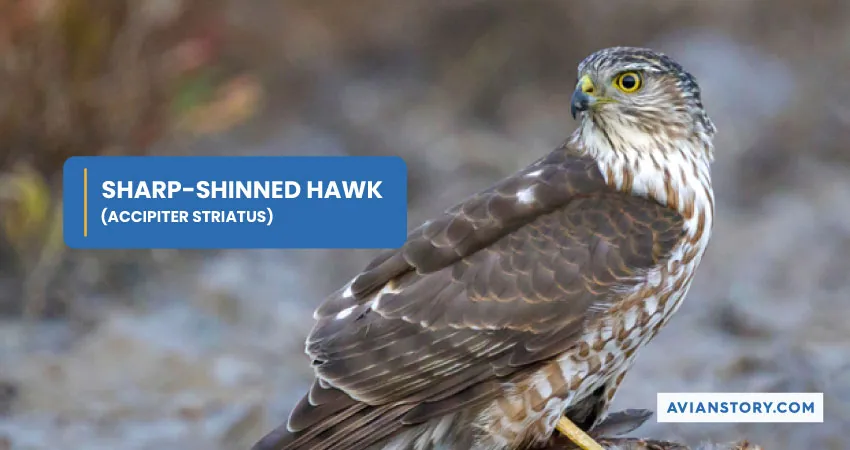
Length: The male sharp-shinned is about 23-30 cm while the female is 29-37 cm.
Weight: Their weight varies from 82 to 250 grams, implying that they can be significantly different sizes.
Wingspan: The average male shows a wingspan of 42 to 58 cm, with excellently graded ash and black colors over the edges.
Commonly found in: Usually, they are found in coniferous forests, and sometimes around deciduous forests, mostly year round. But in winter, when coniferous trees shed, they can be found in bushy, dense forests.
Characteristics:
Sharp-shinned hawks usually migrate in flocks, with hundreds at a time flying over water lands. They might be seen migrating to and from Canada during the season transition.
They are carnivorous and feed mostly on small birds like sparrows, robins, magpies, etc. Moreover, they are hunters but not scavengers.
These birds are avians who lay eggs, and the female tends the younglings before they are set free for independent living. The male is primarily assigned to bring them food.
Male hawks usually fly high, keeping an eye on potential dangers and housing opportunities. They nest in groups and prefer curtained areas of the tree for privacy.
Fun fact:
This species suffered a dangerous level of decline in number in the last century, mostly from the unprecedented use of insecticides. Such as DDT that is being transferred to them through the food chain.
It was not ‘fun’ for them, obviously, but they have made a comeback with the advent of genetically engineered methods of insect control.
2. Species profile: Cooper’s Hawk

Length: 35-50 cm
Weight: 530 grams, or about 1 pound
Wingspan: 29-37 cm
Commonly found in: They are found in both forest and open lands. This species prefers mixed and deciduous forests, woodlands, woodlots, and mountains. Basically, they are not shy and can be easily found in most places.
Characteristics:
These hawks are brave and vigilant, preying with the armor of their speed as they shoot across a long range after having carefully observed their target for some time. They eat small birds, as well as squirrels, insects, and reptiles.
Cooper’s Hawks nest in courtship and prefer to live as families. Their nests are about 50 inches above the ground and are sturdy to keep predators away. Preferred materials for nest building are bones, branches, and bark.
During mating season, the female is guided by the male, where she lays eggs and tends to the younglings for at least 4 weeks. During that time, the male brings them food and watches out for potential dangers.
Fun fact:
Their stealth is their death. In scientific research, 23 percent of Cooper showed a fracture of the chest bone, presumably due to their quick shooting across large forests for the purpose of hunting.
3. Species Profile: Red-shouldered Hawk
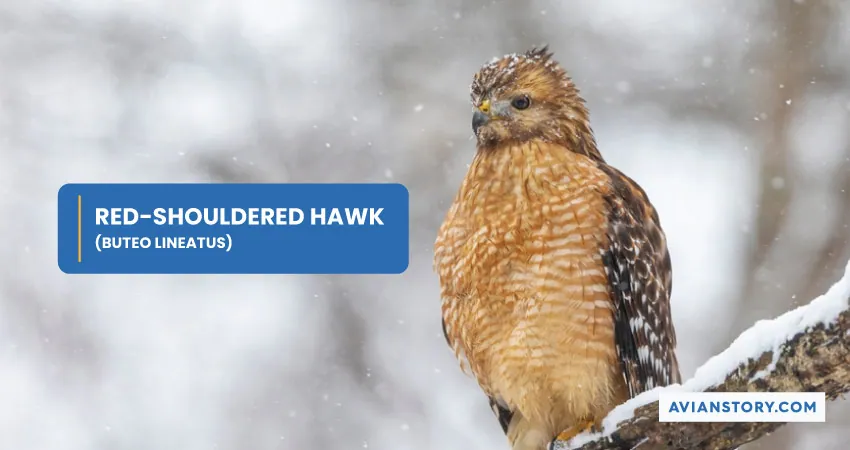
Length: 43-61 cm
Weight: 610 grams
Wingspan: 94-110 cm
Commonly found in: They are usually found in bottomland woods and wooded stream sides. Deciduous and mixed forests, along with open lands, are also harbors of their choice.
Characteristics:
Red-shouldered hawks are birds of unique etiquette. They nest in courtships and often fly in pairs. Their nests are made on trees with sticks, moss, and other flexible materials.
The homemaking process is somewhat romantic, as the male performs a mating dance to lure the female to a location where their new home will be.
They are rapid ave that attacks small creatures and feed on them: such as insects, reptiles, fishes, and small mammals. These hawks usually locate their prey from a height and shoot towards them diagonally or by getting them off guard as the bird flies over at an abnormally low height.
Fun fact:
Their mating dance, also known as a sky dance, is a fascinating ritual. Both male and female circle each other in the sky, while the male dives upwards and downwards in a regular pattern while making a distinct sound.
Moreover, if you were to find these birds relaxing at a certain place, it’s a tell-tale sign that there is going to be water land or very tall trees nearby.
4. Species Profile: Broad-winged hawk
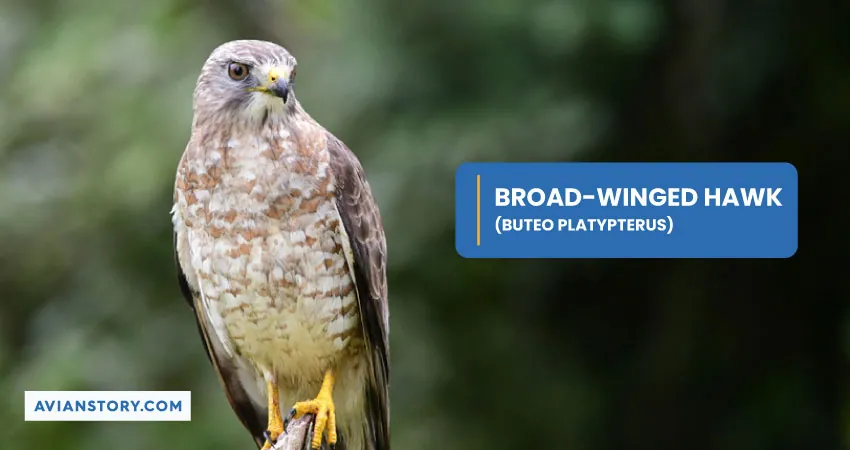
Length: 34-44 cm
Weight: 450 grams
Wingspan: 33 inches
Commonly found in: Usually found in deciduous and mixed forests, groves, and woods. Water land and edges are also their favorite spots.
Characteristics:
Broad-winged hawks are found in spectacular frequency during migratory periods. Although they migrate in flocks, the beginning of flight happens in pairs. Both sexes fly upwards from their nest, and the male fluctuates in altitude while calling out to others.
Their nests are made of lightweight flimsy materials such as straw, sticks, and leaves, and both sexes take part in the making. During breeding, the female stays with the younglings at all times for the first week while the male provides for them.
They feed on reptiles, small mammals, and sometimes tiny fishes. The prey is targeted from a distant height, especially when in forests. These hawks can also be seen walking around water lands, trying to hunt aquatic animals.
Fun fact:
These broad-winged hawks often nest in homes left behind by other animals, such as squirrels.
5. Species Profile: Red-tailed Hawk
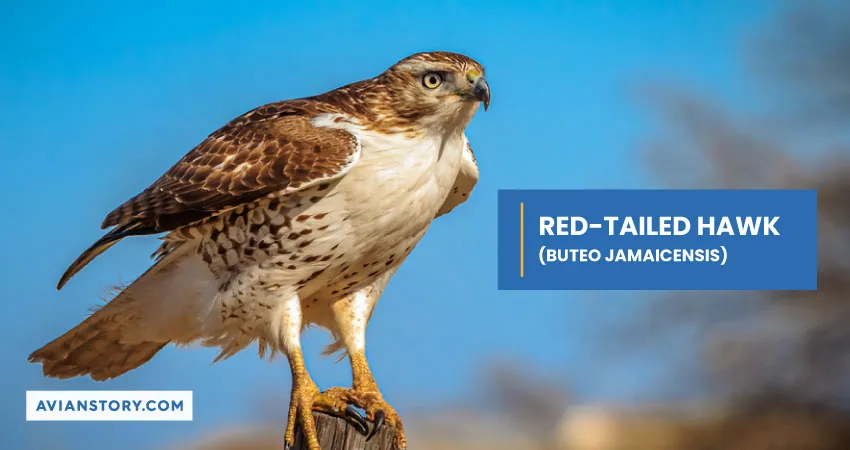
Length: 45-65 cm
Weight: 1.1 kg
Wingspan: 1-1.5 m
Commonly found in: They are usually spotted in open woodland, groves, mountains, countrysides, and open fields.
Characteristics:
Red-tailed hawks feed on mammals and small birds, and their prey is of varied sizes. Smaller prey is taken away to the hawk’s nest, while larger ones are eaten at the place of captivity.
Nests are made high up from the ground, with the hard work of both sexes. Males capture materials for building while female uses them to craft their home. They fly in pairs, as the male flies in a unique maneuver, catching prey in the process and often passing it to the female.
Females stay with the young for the first few weeks, while the male brings food and claws it apart to help the young eat it easily.
Fun fact:
The eyesight of a red-tailed hawk is 8 times more powerful than that of a human.
6. Species Profile: Rough-legged Hawk
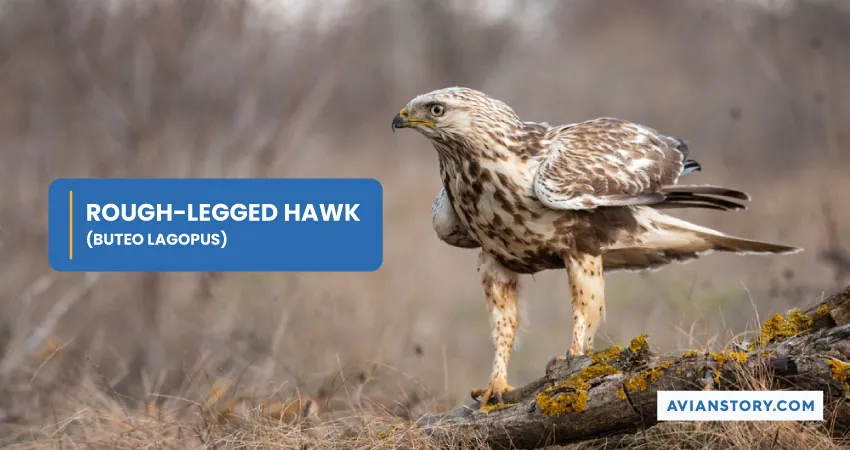
Length: 46-59 cm
Weight: 980 grams
Wingspan: 136 cm
Commonly found in: A bird that loves the winter. Found mostly in Tundra and Arctic coastal areas, it might also be spotted in open country.
Characteristics:
Their name is self-explanatory, with feathers running over their slender legs. They work as warmers to help them survive in cold climates, as they are the only species of this subgenre that prefers winter.
The Rough-legged hawks feed on rodents, small birds, insects, reptiles, and small mammals. Their preferred diet is lemmings, especially for the young. And the number and availability of lemmings act as a determinant for the success of breeding.
They usually fly in groups and nest in pairs. Their nests are found in inconspicuous spaces such as edges, cliffs, and trees. During mating season, the males perform the sky dance to attract the female.
In this newly built home, the female gives birth to the young that she stays with for the first couple weeks of their lives. Meanwhile, the male brings food that the female feeds to the babies.
Later on, when the younglings are capable of independent lives, they leave home.
Fun fact:
This species can hover in one place due to their fast-beating wings
7. Species Profile: Northern Harrier
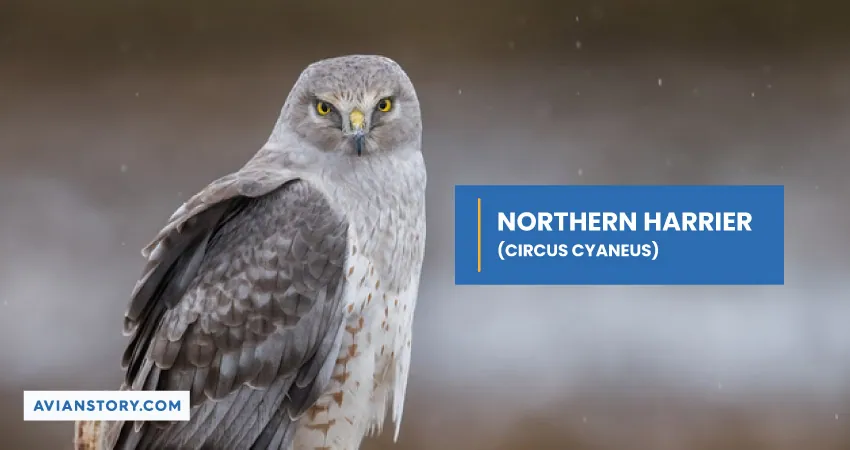
Length: 41-50 cm
Weight: 390 grams
Wingspan: 97-122 cm
Commonly found in: Moorland, prairies, coastal areas, swamps, and water bodies
Characteristics:
The Northern Harriers have the interesting habit of practicing polygamy; that is, one male will mate with several females each breeding season. Their eggs are laid in their nest with sticks and straws.
It’s the male’s duty to feed the younglings, but the female will take care of them until they are capable of separate living.
95 percent of the diet of a harrier consists of small mammals. They eat all sorts of creatures that are smaller than them in size, including voles, reptiles, fishes, and other birds. Their hunting consists of suddenly crashing over open fields after having observed the target for a while.
They nest in colonies due to their polygamous relationship. The male is known to dive up and down in a ‘roller-coaster’ pattern, while the female contributes mostly to the home’s construction.
Unlike other species mentioned in this article, the house of the Harrier stays on the ground within marsh and swamp water.
Fun fact:
Northern Harriers have the incredible hearing capacity. This bird also has an uncanny resemblance to owls.
8. Species Profile: Northern Goshawk
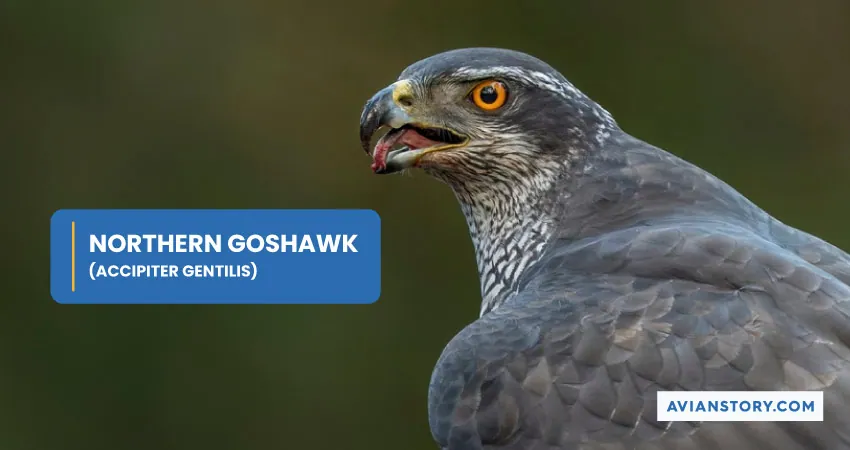
Length: 55-61 cm
Weight: 1.4 kg
Wingspan: 40-47 cm
Commonly found in: Loves wooded areas, especially for breeding. They might also be found in coniferous and mixed forests.
Characteristics:
They hunt by the feat of their rapidity. Their prey is taken by surprise as the Goshawk sprints out of thickened bushes with incredible speed and trick. The diet consists of larger ones compared to the other birds of this genre, such as crows, squirrels, hares, and rabbits.
Interestingly enough, Goshawks might mate for life. The adult bird will perform a courtship dance by putting a display of its white feather at the rear end, accompanied by gliding. Male Goshawks are the ones responsible for food hunting for all their married life.
The female will make their nest, the materials mostly being sticks, straws, and foliage. The home is usually situated about 15-30 cm above the ground. These are used several times by the same pair and are not usually abandoned.
The female watches over the young for the first 5-6 weeks until its first flight. And they are vindictive of all sorts of predators trying to intervene in their nest. The adult Harrier is known to be bold enough to attack humans; if they dare to touch their nest.
Fun fact:
An adult Northern Goshawk can achieve a flight speed of up to 61 miles per hour.
Bottom line
Hawks are usually distinctive in their behaviors, although they might appear strikingly similar to unskilled eyes. Tourists usually confuse all these species for one, and rarely are they known for anything apart from their ivory bellies and ashen wings.
A great way of training your eyes and ears to recognize all these birds in the wild is to visit Audubon.org, where you can look at pictures of all sorts of Hawks and listen to their sounds!
If you happen to spot hawks in North Carolina, we recommend that you appreciate its beauty and elegance from afar. Try not to interfere or interact with it in any way, even if you mean no harm.
